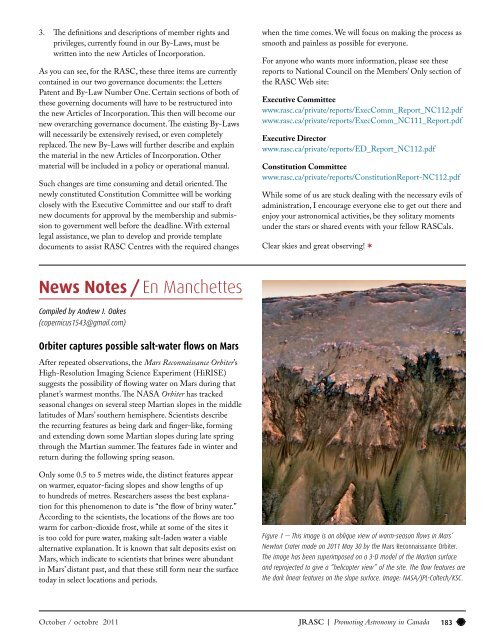The stunning Orion Nebula - The Royal Astronomical Society of ...
The stunning Orion Nebula - The Royal Astronomical Society of ...
The stunning Orion Nebula - The Royal Astronomical Society of ...
Create successful ePaper yourself
Turn your PDF publications into a flip-book with our unique Google optimized e-Paper software.
3. <strong>The</strong> definitions and descriptions <strong>of</strong> member rights and<br />
privileges, currently found in our By-Laws, must be<br />
written into the new Articles <strong>of</strong> Incorporation.<br />
As you can see, for the RASC, these three items are currently<br />
contained in our two governance documents: the Letters<br />
Patent and By-Law Number One. Certain sections <strong>of</strong> both <strong>of</strong><br />
these governing documents will have to be restructured into<br />
the new Articles <strong>of</strong> Incorporation. This then will become our<br />
new overarching governance document. <strong>The</strong> existing By-Laws<br />
will necessarily be extensively revised, or even completely<br />
replaced. <strong>The</strong> new By-Laws will further describe and explain<br />
the material in the new Articles <strong>of</strong> Incorporation. Other<br />
material will be included in a policy or operational manual.<br />
Such changes are time consuming and detail oriented. <strong>The</strong><br />
newly constituted Constitution Committee will be working<br />
closely with the Executive Committee and our staff to draft<br />
new documents for approval by the membership and submission<br />
to government well before the deadline. With external<br />
legal assistance, we plan to develop and provide template<br />
documents to assist RASC Centres with the required changes<br />
News Notes / En Manchettes<br />
Compiled by Andrew I. Oakes<br />
(copernicus1543@gmail.com)<br />
Orbiter captures possible salt-water flows on Mars<br />
After repeated observations, the Mars Reconnaissance Orbiter’s<br />
High-Resolution Imaging Science Experiment (HiRISE)<br />
suggests the possibility <strong>of</strong> flowing water on Mars during that<br />
planet’s warmest months. <strong>The</strong> NASA Orbiter has tracked<br />
seasonal changes on several steep Martian slopes in the middle<br />
latitudes <strong>of</strong> Mars’ southern hemisphere. Scientists describe<br />
the recurring features as being dark and finger-like, forming<br />
and extending down some Martian slopes during late spring<br />
through the Martian summer. <strong>The</strong> features fade in winter and<br />
return during the following spring season.<br />
Only some 0.5 to 5 metres wide, the distinct features appear<br />
on warmer, equator-facing slopes and show lengths <strong>of</strong> up<br />
to hundreds <strong>of</strong> metres. Researchers assess the best explanation<br />
for this phenomenon to date is “the flow <strong>of</strong> briny water.”<br />
According to the scientists, the locations <strong>of</strong> the flows are too<br />
warm for carbon-dioxide frost, while at some <strong>of</strong> the sites it<br />
is too cold for pure water, making salt-laden water a viable<br />
alternative explanation. It is known that salt deposits exist on<br />
Mars, which indicate to scientists that brines were abundant<br />
in Mars’ distant past, and that these still form near the surface<br />
today in select locations and periods.<br />
when the time comes. We will focus on making the process as<br />
smooth and painless as possible for everyone.<br />
For anyone who wants more information, please see these<br />
reports to National Council on the Members’ Only section <strong>of</strong><br />
the RASC Web site:<br />
Executive Committee<br />
www.rasc.ca/private/reports/ExecComm_Report_NC112.pdf<br />
www.rasc.ca/private/reports/ExecComm_NC111_Report.pdf<br />
Executive Director<br />
www.rasc.ca/private/reports/ED_Report_NC112.pdf<br />
Constitution Committee<br />
www.rasc.ca/private/reports/ConstitutionReport-NC112.pdf<br />
While some <strong>of</strong> us are stuck dealing with the necessary evils <strong>of</strong><br />
administration, I encourage everyone else to get out there and<br />
enjoy your astronomical activities, be they solitary moments<br />
under the stars or shared events with your fellow RASCals.<br />
Clear skies and great observing! V<br />
Figure 1 — This image is an oblique view <strong>of</strong> warm-season flows in Mars’<br />
Newton Crater made on 2011 May 30 by the Mars Reconnaissance Orbiter.<br />
<strong>The</strong> image has been superimposed on a 3-D model <strong>of</strong> the Martian surface<br />
and reprojected to give a “helicopter view” <strong>of</strong> the site. <strong>The</strong> flow features are<br />
the dark linear features on the slope surface. Image: NASA/JPL-Caltech/KSC.<br />
October / octobre 2011 JRASC | Promoting Astronomy in Canada<br />
183

















